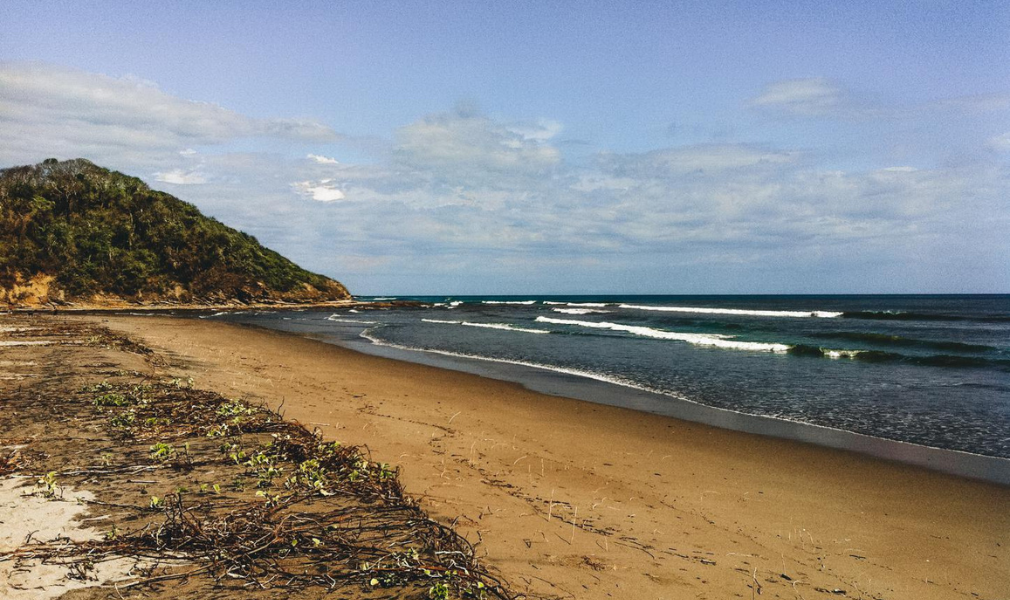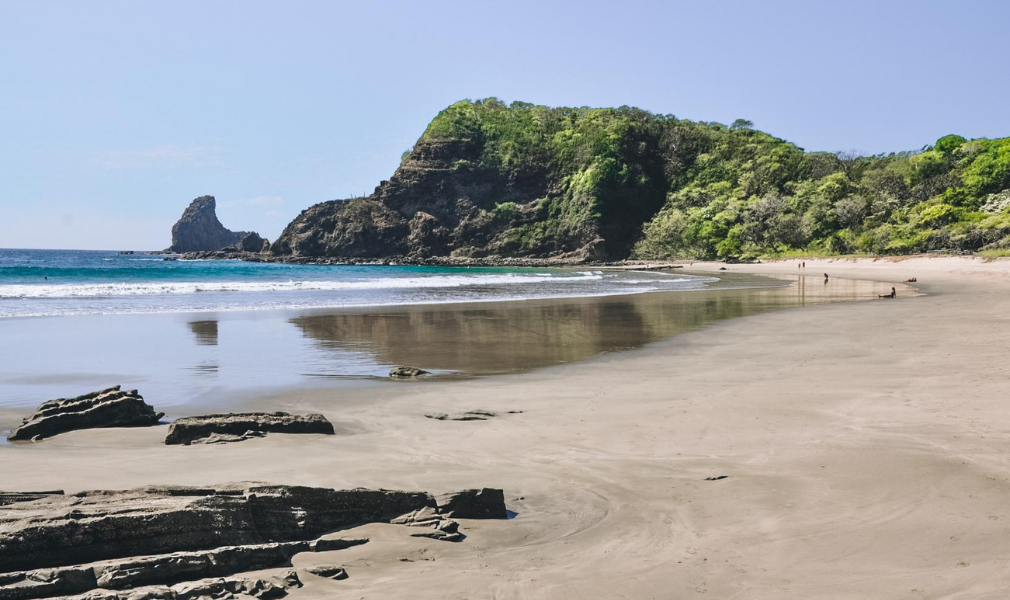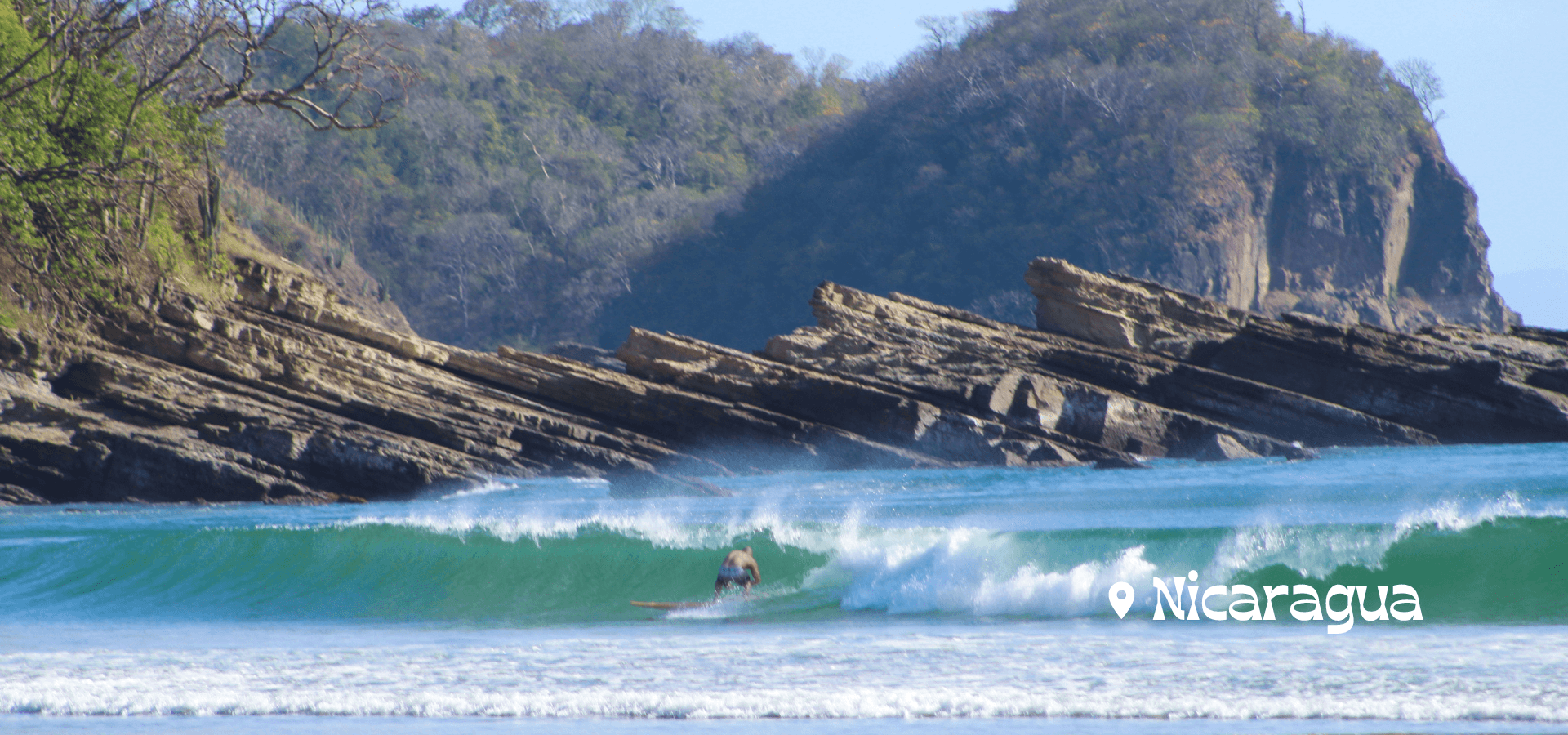Nicaragua is a true year-round surf destination and one of the only places on the planet that can actually boast more than 300 days of offshore wind per year—a phenomenon that can be attributed to its two massive inland lakes that create a kind of wind corridor between the Americas’ otherwise continuous spine of mountain ranges.
Most of Nicaragua’s best waves can be found during the soggy, south swell months of March to August along what’s known as its Emerald Coast, a 30-mile stretch of Pacific coastline in the country’s jungly southwest. This warm, 80-ish-degree section of sea is beholden with barrels, wide open offshore-fed faces, endless A-frames to suit every level, and even a pipeline-style slab for the boldest of riders.
In this surfer’s guide to Nicaragua, we brief you on all of the best spots in Nicaragua’s enviable roster, from the all-level breaks of Popoyo to the boat access-only barrels of Playa Colorado and more.

Popoyo
Popoyo tops this list for its ability to cater to all surf levels across a mix of beach, reef, and point breaks. Spanning a long swath of surf lodge-lined beach, the Popoyo territory begins with Playa Santana in the south, covers the sands of Playa Popoyo and Beginner Bay on either side of the iconic promontory peak called Mag Rock, and finishes at Playa Guasacate at its north end. Playa Santana boasts fast, almond-shaped barrels and wedgy A-frames over a mostly sand-bottomed beach break. Beginner Bay, on the other hand, is a mellow and mushy left point break with sandy bottom sections and reef and rock shallows. Then, there’s the namesake Popoyo surf spot that defines the region. It’s a powerful right and left reef break that works with just about any swell. Popoyo Outer Reef—the offshore slab that’s a quick paddle from Popoyo—comes alive a few times a year, delivering a powerful, pipeline-style left that’s for big-wave surfers only.
Playgrounds
Playgrounds is a boat access-only break located just offshore of Nicaragua’s Chacocente Wildlife Refuge and its secluded beach of Veracruz de Acay. Surfers have dubbed it Playgrounds due to the long, rippable rides, split peaks, and hollow barrels that break over a cobblestone seafloor. This surf spot can be divided by the two breaks: Playgrounds Left and Playgrounds Right. Playgrounds Left is the longer ride of the two, with rippable walls, big shoulders, and speedy inside sections, while the steeper, more hollow Playgrounds Right tends to be shorter, shallower, and more likely to barrel and test you with high-performance sections. Also in the area, you’ll find Chacocente, a multi-peak beach break with barreling rights and lefts; Lance’s Left, an all-level left point break that sometimes promises 200-yard-plus rides when the conditions are right; and Astillero, a powerful point break known for its hollow waves, double overheads, and relatively crowd-free lineup.

Playa Maderas
Located just north of San Juan del Sur in southwestern Nicaragua, Playa Maderas is a laidback bay and beach break with waves suitable for all levels. The biggest swell rolls in during the region’s wet months (end of May through November), coalescing with the ocean stirrings from the winter storms in the southern hemisphere. It’s not uncommon to see a double overhead barreling swell this time of year. Otherwise, expect beginner-friendly peeling A-frames and an easy paddle out via its two rock-hugging channels on either side of the break. PSA: It can get a bit crowded with all of the surf schools in the area. But if you stick to the early morning hours, a low tide on a small swell, or target the big swell days, the crowds will certainly thin out for you. When too big or heavy, beginners can check out nearby Playa Remanso where the waves are much gentler; intermediate riders can try Playa Hermosa, which is always a bit less powerful than whatever Playa Maderas has going on.

Playa Colorado
Situated between Popoyo and Gigante, Playa Colorado is best known for its bountiful barrels and year-round consistency. Your best bet for scoring the most epic tube ride of your life is to stay inside the Hacienda Iguana Golf & Beach Club, the gated community situated right in front of Playa Colorado’s fast and barreling beach and river mouth break. If condo living is outside your surf trip budget, you could hire a boat from neighboring spots like Gigante, Popoyo, or Astillero, where budget surf hostels abound. Ask your boat to park just near the river mouth on the north end of the beach, where a sandbar generates some fun rights and lefts on a south swell and powerful, overhead barrels with the right west swell.
Panga Drops
Located just a 15-minute walk north of Playa Colorado, Panga Drops is probably one of the most consistent—and often one of the biggest—waves in Nicaragua. If you can manage the long paddle out, you’ll be rewarded with relatively crowd-free shifting lefts and rights with the occasional barrel and, more consistently, long rippable walls. It’s a deepwater, horseshoe-shaped reef break that amplifies any swell headed its way, meaning it’s nearly always the biggest wave around and can grow to double and triple overhead fast. On smaller days, it’s pretty mellow and manageable for the newly intermediate; just keep tabs on the wind, rip currents, and tide for your paddle out.

Playa Manzanillo
Another boat-only break, unless you’re staying at the five-star Mukul Resort that fronts its private shoreline, Playa Manzanillo is a left point break in a gorgeous location with towering cliffs as your backdrop. Situated about halfway between Playa Maderas and Popoyo and even closer to Gigante, this gem of a Nicaragua surf spot, though fickle, does tend to work on a variety of swells, with the best being a big south or west swell. Its long, open, rippable face, barreling sections, and easy takeoff make this one of Nicaragua’s most playful waves for intermediates and up. Be aware, however, that it can get dangerously heavy when it’s more than a foot or two overhead and there’s always the risk of a run-in with the sea urchins of the reef beneath.
Want more of our surf guides to top destinations around the world? Find them here.










